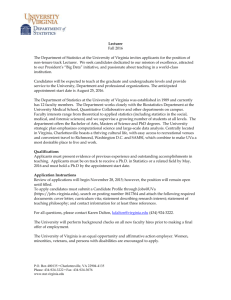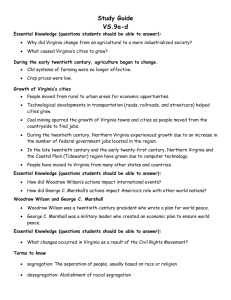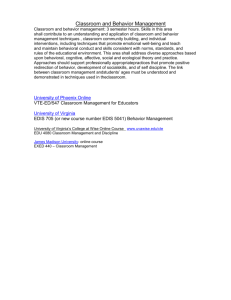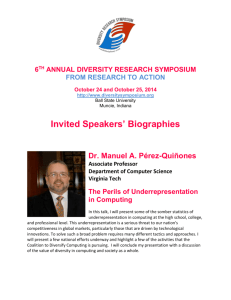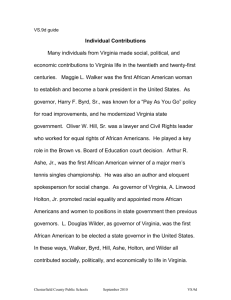20th Century Virginia History Study Guide
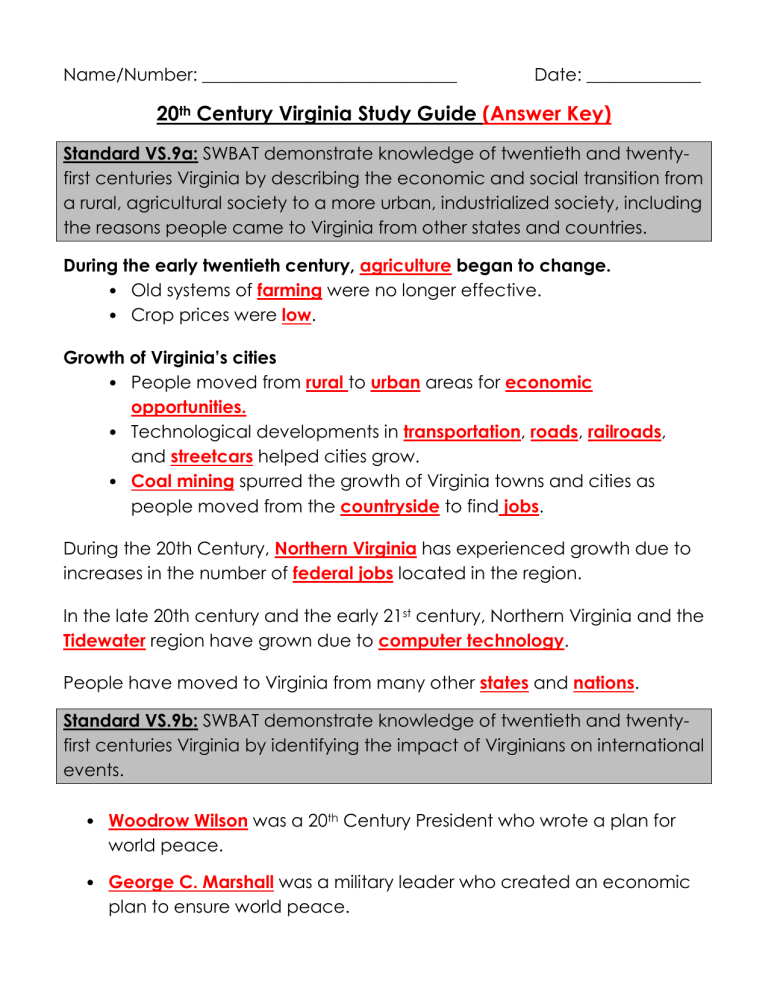
Name/Number: _____________________________ Date: _____________
20
th
Century Virginia Study Guide (Answer Key)
Standard VS.9a: SWBAT demonstrate knowledge of twentieth and twentyfirst centuries Virginia by describing the economic and social transition from a rural, agricultural society to a more urban, industrialized society, including the reasons people came to Virginia from other states and countries.
During the early twentieth century, agriculture began to change.
•
Old systems of farming were no longer effective.
•
Crop prices were low .
Growth of Virginia’s cities
•
People moved from rural to urban areas for economic opportunities.
•
Technological developments in transportation , roads , railroads , and streetcars helped cities grow.
•
Coal mining spurred the growth of Virginia towns and cities as people moved from the countryside to find jobs .
During the 20th Century, Northern Virginia has experienced growth due to increases in the number of federal jobs located in the region.
In the late 20th century and the early 21 st century, Northern Virginia and the
Tidewater region have grown due to computer technology .
People have moved to Virginia from many other states and nations .
Standard VS.9b: SWBAT demonstrate knowledge of twentieth and twentyfirst centuries Virginia by identifying the impact of Virginians on international events.
•
Woodrow Wilson was a 20 th Century President who wrote a plan for world peace.
•
George C. Marshall was a military leader who created an economic plan to ensure world peace.
Standard VS.9c: SWBAT demonstrate knowledge of twentieth and twentyfirst centuries Virginia by identifying the social and political events in Virginia linked to desegregation and Massive Resistance and their relationship to national history.
Terms to know:
•
Segregation: The separation of people, usually based on race or religion .
•
Desegregation: Abolishment of racial segregation
•
Integration: Full equality of all races in the use of public facilities
Desegregation and Massive Resistance in Virginia
•
The U.S. Supreme Court ruled in 1954 ( Brown v. Board of Education ) that
“separate but equal” public schools were unconstitutional .
•
All public schools, including those in Virginia, were ordered to desegregate .
•
Virginia’s government established a policy of Massive Resistance , which fought to “ resist ” the integration of public schools.
•
Some schools were closed to avoid integration .
•
The policy of Massive Resistance failed, and Virginia’s public schools were integrated .
•
Harry F. Byrd, Sr ., led a Massive Resistance Movement against the desegregation of public schools.
Standard VS.9d: SWBAT demonstrate knowledge of twentieth and twentyfirst centuries Virginia by identifying the political, social, and/or economic contributions made by famous Virginians.
Citizens who made political, social, and/or economic contributions:
•
Maggie L. Walker was the first African American woman to establish and become a bank president in the United States.
•
Harry F. Byrd, Sr., as governor, was known for a “Pay As You Go” policy for road improvements , and he modernized Virginia state government.
•
Oliver W. Hill, Sr., was a lawyer and civil rights leader who worked for equal rights of African Americans. He played a key role in the Brown v.
Board of Education decision.
•
Arthur R. Ashe, Jr., was the first African American winner of a major men’s tennis singles championship. He was also an author and eloquent spokesperson for social change.
•
Linwood Holton, Jr.
, as governor of Virginia, promoted racial equality and appointed more African Americans and women to positions in state government than previous governors.
•
L. Douglas Wilder , as governor of Virginia, was the first African American to be elected a state governor in the United States .

